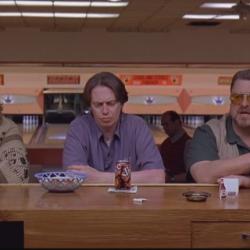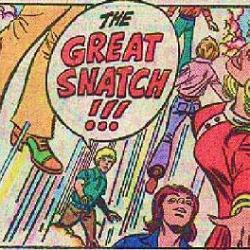Originally posted January 17, 2009.
You can read this entire series, for free, via the convenient Left Behind Index. This post is also part of the ebook collection The Anti-Christ Handbook: Volume 1, available on Amazon for just $2.99. Abolish ICE. Burn it down. Salt the earth. Prosecute its leaders. Volume 2 of The Anti-Christ Handbook, completing all the posts on the first Left Behind book, is also now available.
Left Behind: The Movie [2000] has conveniently been divided into 11 parts for posting on YouTube. This neatly provides us with stopping points as well as the ability to watch together as we work our way through the movie. Today we look at part 9 of 11. [Note: That 11-part bootleg is no longer on YouTube, but the entire 2000 movie is here. You can still watch along if you’re masochistic enough to want to do so.]
Mrs. Cameron doesn’t approve of Hattie Durham’s behavior here and she doesn’t want viewers to approve of it either.
That disapproval is evident here. And because we can see that disapproval, we can also see the person doing the disapproving — the actress Chelsea Noble. And since there isn’t room here for both the actress and the character, Hattie gets squeezed out. We can’t glean whatever it was that motivated Hattie to go to Rayford’s house and beg/threaten/negotiate for their future in this scene, because the only motivation we see here is Chelsea’s, not Hattie’s.
This is part of why actors so often say that they won’t or can’t or mustn’t judge the characters they play. It’s almost impossible to decide that you approve or disapprove of the character or the character’s actions without conveying that approval or disapproval instead of those actions. Such judgments can’t be made to fit inside of the story you’re trying to tell and they usually wind up taking both you and your audience outside of the story. This same judging afflicts Mr. Cameron’s acting in LBTM as well. It’s slightly less intrusive in his case because he regards Buck as a positive character, but it’s still often obvious that this is what we are watching — not Buck Williams, but Kirk Cameron regarding Buck Williams with approval and asking us to share this approval.
This story-destroying judgment of Hattie happens in the novel too, which is why neither the book nor the movie offers any credible explanation for the whole pseudo-affair between Hattie and Rayford. We’re never shown or led to believe that either of these people loved or was capable of loving the other. Instead we’re just told that they were sinning. And since the moral universe of LB requires that sin is always a deliberate, unambiguous act of willful disobedience, neither the book nor the movie ever allows for the possibility of any other motive for their affair. Thus we get this scene, which boils down to something like:
In all the history of sin and sinning, no two real sinners have ever had such a conversation.
Hattie runs out and hops into a Jeep driven by a random chinless bearded guy. There’s some kind of flashing light going on, so maybe he’s supposed to be a military escort for U.N. Big Shot Hattie. But the Jeep looks more like the kind you’d see parked outside a college dorm than like an official vehicle. If not an official driver, then, who is this guy? He agreed to come along and wait quietly in the car while Hattie ran inside to drop some ultimatums on her married/newly widowered pseudo-boyfriend. There are very few non-creepy explanations for why any man would agree to do that.
Back inside we have another half-decent interlude of father-daughter discussion. The dialogue isn’t remarkable, but it’s not remarkably bad either, which is an improvement on both the source material and on the preceding scene with Hattie.
“Is that why you never had time for us?” Chloe asks, having overheard enough to figure out that something had been going on between her father and this woman who wasn’t her mother.
“No, that’s not it at all,” Rayford says.
Tim LaHaye said that the inspiration for the Left Behind books came from seeing an airline pilot who wore a wedding ring flirting with a flight attendant. He described this for beliefnet:
I was flying across the country to a prophecy conference, and this handsome 40-ish airline pilot stepped out of the cabin and he started flirting with the chief stewardess in the galley there. I looked down and noticed that he had a wedding ring on, and I looked at her finger and she didn’t have one on. I got to thinking, ‘Oh, these people are pretty friendly.’ And then I got to thinking … What if the Rapture took place?
That’s how LaHaye thinks. Any time he gets to thinking, it always leads to this same thought: “What if the Rapture took place right now?”*
LaHaye is fond of telling that story of about seeing the philandering pilot and thus getting inspired to write these books. It seems important to him. So it probably didn’t please him that the screenwriters here say, “No, that’s not it at all,” and essentially concede that the whole Rayford/Hattie subplot is a dead-end they don’t want to waste any more time exploring. And it’s just possible this was a factor in LaHaye’s spending nine years in court fighting for the rights to remake this film more to his liking.
Anyway this father/daughter scene almost works. It works far better than the preceding bit with Hattie because Janaya Stephens — unlike Mr. & Mrs. CamCam — continues acting even when Chloe isn’t the person talking.
Rayford’s comment here that he resented Irene’s “church stuff … because I didn’t want her to need anything more than she needed me” fits in nicely with — and could help to explain and humanize — the control-freak behavior of the Rayford we know from the book.
“Are you telling me that they’re dead?” Chloe asks, “That they’re not coming back?” These are, again, questions that everyone in this story should be asking, over and over.
“They’re not coming back, baby,” Rayford says. Like LaHaye, he leaves unanswered the question of how “not coming back” is in any meaningful way distinct from “dead.”
“You mother left us with the truth,” Rayford tells his daughter. That strikes me as more likely to succeed than the approach he takes in the book of nagging and begging Chloe to watch a videotape.
The scene falls apart when Chloe asks, as she does in the book, about the sort of vindictive God who would carry out this merciless apocalypse and then, just like in the book, Rayford is unable to answer her.

Back in Manhattan, CamCam is playing with a parakeet while the hippy chicks do all the heavy lifting on researching the conspiracy. Again, little here makes any sense at all. The elements of this conspiracy and how they supposedly tie together sounds like Ivy is playing MadLibs. And placing this scene immediately after the one with Chloe just underscores the deeply warped strangeness of these people sitting around not asking the questions we’ve heard from her: “Where are they? Are they dead? Are they coming back? What could be worse than this?
Alan Tompkins calls. Movie-Alan is an FBI agent in Chicago instead of a Scotland Yard officer in London, but both Alans exist exclusively within the bubble of Buck’s alternate-universe thriller subplot.
A single-engine plane lands on a runway somewhere, but there’s no location printed rat-a-tat on the screen so we can only guess where we are. I think it’s Ken Ritz’s plane, though, so we must still be within the 48 hours for which Buck hired him the day after the Event, which means we’re at most three days into our story, even though we’ve seen a week’s worth of sunrises and sunsets and … oh, never mind.We see CamCam and Alan in an otherwise almost-empty bar, presumably in Chicago. I’d expect to see more people there due to the recent trauma and the fact that all the non-Muslim teetotallers have vanished, but it’s just our heroes and a drunk lady who seems to have been written by some evangelical who’s never actually set foot in a bar.
Alan Tompkins is played here by Philip Akin, another Canadian** actor slumming for a paycheck. You may recognize him. Where exactly you recognize him from would reveal something about your taste in weekend and late night syndicated TV. (For me, it’s Highlander.)
They discuss the Event, but in a way that makes it seem abstract or like some kind of isolated occurrence in a small town far away. “Officially, it’s radiation,” Alan says. “Unofficially, the agency’s running scared from the top down.”
That, at least, is a recognition that even if the gullible population could be conned into believing the ludicrous “accumulated radiation” explanation, the officials knowingly spreading this cover story would remain, themselves, unsure of what happened or why or how or whether it might strike again at any moment.
But the unexplained disappearance of 2 billion people doesn’t for long distract Buck and Alan from the more pressing questions at hand: Who killed Dirk Burton and why?
Alan gives CamCam yet another disc of information from Dirk, which he says is all, “financial stuff” having to do with a couple of bankers. Moments later, after an extravagantly furtive CamCam puts the pieces together and explains the conspiracy, Alan looks incredulous: “You mean it’s all about money?” Yes, who could have guessed? The financial doings of international financiers wind up being all about money.
The conspiracy itself — the maguffin the book never bothers to explain — has something to do with cornering the world market on food. It involves trading a Temple for a formula and spending billions to bankrupt the U.N. in order to force the U.N. to give them the formula and 10 tracts of land. How the bankrupt U.N. is supposed to acquire that land or why it’s involved at all in this scheme isn’t really clear. (I’m certain though that at some point in their scheming, Cothran asked why they didn’t just use their billions of dollars to buy the land, to which I’m sure Stonagal replied, “Because that’s just what they’d expect us to do.”)
That all makes little more sense than the hodge-podge of unexplained conspiring going on in the novel, but at least here Nicolae doesn’t seem to be directly involved. He appears to be Stonagal’s unwitting “puppet,” rather than his willing accomplice, which lets movie-Buck deal with him later without having to agree, as book-Buck does, to help the conspiracy cover its tracks.
CamCam agrees to go with Alan to a “safe house” until they figure out who killed Dirk but on their way to the car, he is detained by the alcoholic Sunday school teacher from inside, pleading for a dollar so she can go back in to finish getting her drink on. Alan gets in the car and, of course, boom.
The car bomb is much more convincing than the explosions earlier from the Russian missiles. The impact knocks CamCam over. He falls on his back, clutches his shin and begins bleeding from the thigh.
Sinister Guy — the same one who shot out Dirk’s monitor back in New York — peers out of a window and smiles. So, OK, he’s been watching and now he’s smiling, so this must be the outcome he was hoping for: Alan dead and Buck still alive. But that would mean the Sunday school teacher was working for him — that he sent her to prevent Buck from getting blown up in the car. We see a Significant Close-up of the old lady, but what that’s supposed to mean I have no idea.
The sun rises (Day 4?) on the Steele home, where CamCam, still bleeding, has fled for shelter. “I’m sorry to come here,” he says. “But you’re the only ones they don’t know.”
“My friends are dead,” he adds.
Rayford and Chloe help CamCam to the couch, where he collapses, babbling. He’d used the last of his strength, apparently, walking from downtown Chicago out to Wheaton.
– – – – – – – – – – – –
* It’s hard to know what to make of LaHaye’s “what if” scenario here. My reading of LaHaye’s theology is that he believes born-again, real, true Christians get raptured and non-RTCs do not. So a born-again pilot would still get taken even if, at the very moment the Rapture occurs, he and his chief flight attendant are renewing their membership in the Mile High Club. If, on the other hand, the pilot is not born-again, then it won’t help him any to have been wholly and unerringly faithful to his wife. A loyal husband non-RTC would still get left behind.
The pilot’s flirtation would seem to be irrelevant to the question of his status as saved or unsaved. “Faith, not works” is how LaHaye would put this.
By asking “What if the Rapture took place?” just as the pilot was flirting with the flight attendant, LaHaye seems to suggest he believes something else. That question seems to make salvation/Rapture conditional and tenuous — something like what Hamlet describes in “Now might I do it pat.” There Hamlet opts not to kill Claudius when he finds the wicked man on his knees, apparently at prayer, because he does not want Claudius to die in a state of grace:
Up, sword; and know thou a more horrid hent:
When he is drunk asleep, or in his rage,
Or in the incestuous pleasure of his bed;
At gaming, swearing, or about some act
That has no relish of salvation in’t;
Then trip him, that his heels may kick at heaven,
And that his soul may be as damn’d and black
As hell, whereto it goes.
** While I was still chuckling over the Canadian provincial flags outside the “United Nations” in last week’s installment, manfre e-mailed to note that, for anyone familiar with Toronto, it’s obvious that Nicolae’s U.N. office is not in Manhattan:
The interior of the “U.N.” building in the Left Behind movie is being played by some east-facing room in the pointy-topped middle building of Toronto’s Metro Hall complex, part of the city government offices and right next to the CBC broadcast building (the other two buildings in the Metro Hall complex are visible to the sides out the window behind CamCam). … [The filmmakers] try to pass off a view of Toronto that’s obviously Toronto … as a view of midtown Manhattan. They might as well put the camera in the next building over so they can pan over to the CN Tower and Lake Ontario. …












